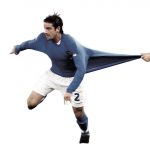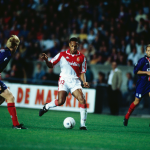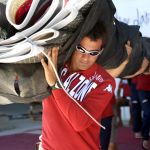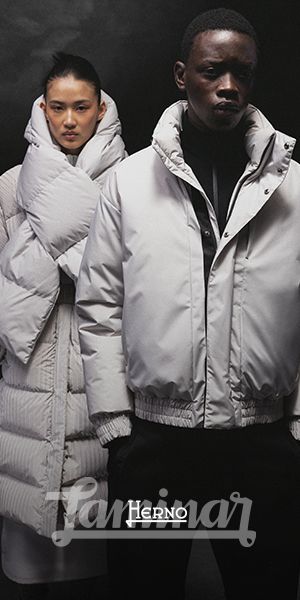
Kappa and the aesthetic definition of sports
The history of Kappa, from space shuttle to napkin
January 10th, 2019
The 'Calzificio Torinese', founded by Abramo Vitale, is the place from which the story of Kappa began, one of the most iconic brands in the history of sports. But also the brave to jump inside the turning points that have then determined the fortune of the brand and changed the aesthetics of sportswear. The label has never abandoned its factory in Turin, building a futuristic and visionary identity in the '80s, evolved in recent years to embody the football antithesis between nostalgia and technology, not betraying his mission.
Kappa and football have a special relationship, for having represented, since the 80s and more fully in the 90s, the aesthetics of football, dressing some of the most victorious teams in Europe such as AC Milan, Juventus and Barcelona, becoming a symbol of a decade of sporting memories.

Kappa on the pitch
One of these turning points occurred in 1956, a faulty stock of socks manufactured by Maglificio Calzaturificio Torinese (MCT), a company established by Abramo Vitale in 1916, was mistakenly distributed on the market. Retailers returned the goods and MCT, to give the product renewed strength and credibility, branded the new collection’s packaging with a “K” and the German caption “Kontroll”. From that moment customers only ordered the socks with the K – and in a short time, Kappa became a leader of the socks and underwear market. In 1969 the brand found a way to consolidate its image. From the imaginative powers of Maurizio Vitale, the Omini logo was born, a simple and visually effective silhouette that from that moment will characterize all the lines produced by Kappa.
The second crucial moment in this story was in 1978, Marco Boglione – MCT’s young sales and marketing director – picked up on the demand for technical sportswear and convinced Maurizio Vitale to establish a dedicated department, Robe di Kappa Sport renamed a few years later simply as Kappa. The proposal was accepted and Vitale, after a trip to New York, was convinced that sportswear could become the new jeans. Kappa initially began to sponsor Cabrini, a debutant at the 1978 World Cup in Argentina, then Tardelli, both symbols of the most prestigious team of Italy at the time. The following year the possibilities of success of the project were real, the limits of an anonymous sponsorship were knocked down and the duo Vitale-Boglione met Giampiero Boniperti, the Juventus president at the time, proposing to put the Omini on the black and white jersey. The president initially did not understand the sense of the proposal, but he accepted thanks to the CEO, Doc. Giuliano, who convince Boniperti to close the deal. For the first time, a sports brand logo ends up on the jersey of legends such as Zoff, Bettega, and Scirea.
Destination Mars
The face of the uniforms changes, but this is not just a superficial shift, but an epoch-making change in the process of improvement of the sporting gesture in general. The collaboration between Kappa and Juve had as objective, in fact, to work with the clubs not only on a superficial level but to improve sports performance, a complete novelty, to overcome the traditional wool fabrics that limited the spectacularity of the action.
In a bar, in New York, Maurizio Vitale concludes a million dollar sponsorship deal with the American track team, the bar had been finally raised, the 222 banda invades the Los Angeles Olympics Game in 1984. Kappa's moved the challenge to the fabric and asked the help of NASA, which supported to design increasingly high-performance materials, to repair the athletes from the sun's rays and keep their body temperature stable. US athletes won 40 medals only in athletics disciplines, 28 more than West Germany, second in the medal standings. It drew attention a special hooded suit, which thinned the volume of the body, favoring aerodynamics during the race. Suddenly the fabrics passed in the foreground and the new technologies start to represent a new business opportunity for sports brands.
The sport understood that looking at the present was not enough anymore, the technology of the uniforms changed considerably, driven above all by the innovations proposed by Nike in the following years. Within a much more competitive world than in 1984, Kappa finds a new turning point.
A new skin
Robe di Kappa Sport's dream was to sponsor the Italian national football team and look for a new expression of technicality. The occasion happened after the end of the Nike contract with the Italian national team, after the France World Cup in 1998. Emanuele Ostini came up with the idea of taking inspiration from the world of surf, its completely slim sweaters, and thus changing the classic fit of the traditional jerseys, fluttering, oversize and elaborate in design.
The purpose that moved the project was still to help sports performance. Kappa wants to give the player 50 cm action more in the penalty area, taking advantage of a new elasticity of the fabric, an extra chance for the players, as well as a way to accentuate the restraints in the eyes of the referees. The new Kombat shirt sculpted the body of the players and, adjusting to the physical, created a sort of unique personalization. The eyes of the press will fall on Italy during Euro 2000 when the new model officially was worn for the first time. Bruno Pizzul in commentary confirmed his enthusiasm about the "beautiful blue color, the traditional one". Dino Zoff's national team reached the final and the interest in Kombat was high.
Approvals to the work carried out by the Kappa research and development center came at the end of the competition, when Ian Todd, at the time marketing manager of Nike, personally called Marco Boglione, praise for the project and not hiding the sincere envy of not being able to think first of that concept.
20 years have passed since the Totti 'Panenka' penalty against Van der Sar, and Kappa has applied the model of Kombat also for Rugby, Ski, Tennis and more. The other sportswear brands have been able to take the same road beaten by the Italian brand.

Kappa open his archive
Kappa's now owned by Marco Boglione, who saved the Omini from bankruptcy in 1994. Now is part of BasicNet, a global network of 400 entrepreneurs all over the world that guarantees in over 120 markets the presence and diffusion of products Kappa, Robe di Kappa, Jesus Jeans, Superga, Kway, Sabelt. After 60 years, the K-Kontroll collection was also re-launched, recognizing the past with a street vision, drawing on the archive as a way to consolidate the tradition and following a precise and coherent aesthetic. The world of fashion, as well as the football one, in recent years, have rediscovered the heritage of Kappa and the charm of the nostalgic ingredient.
Just to satisfy what seems a widespread need for melancholy, in collaboration with the team of nss sports, Kappa organized, during the next edition of White Street Market to be held in Milan this weekend, the exhibition "KAPPA - Above the football jersey", in which 15 vintage jerseys will be shown. From the Barcelona Ronaldo jersey to that of Van Basten and Zinedine Zidane. The Holy Grail for retro football fans.
"We can be good, smart, funny and use technology, but we must never forget that it's a battle. Kombat could be the synthesis of BasicNet, in the name, there is a piece of our DNA, we fight "(M. Boglione)




























